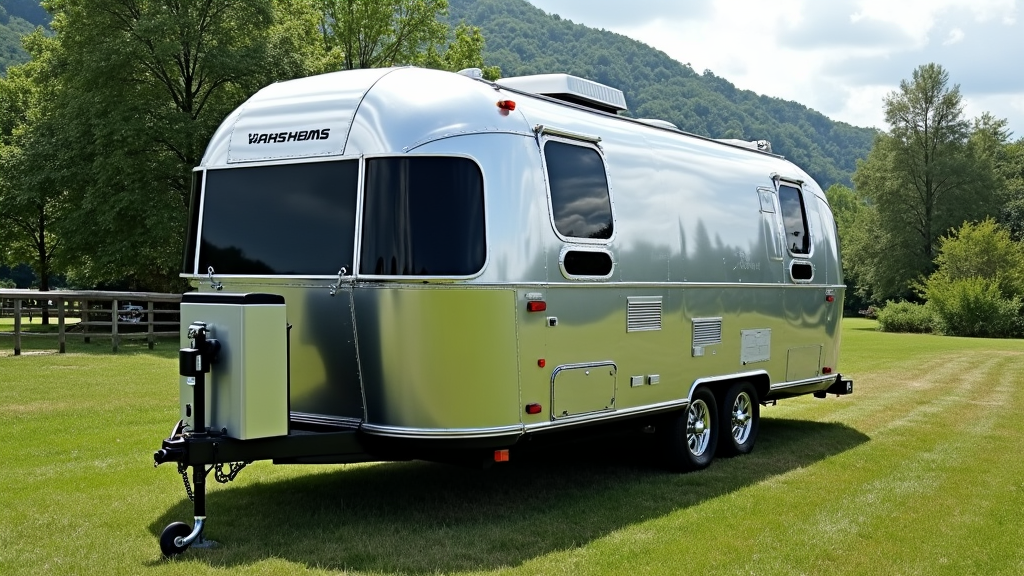Eco-friendly travel can be rewarding for both the planet and the people exploring it. RVs get a lot of attention in the travel world, but not all of them match the push for greener adventures. One brand that’s making a real difference is Airstream.
If you’re trying to lower your travel footprint but still enjoy some comfort and style, Airstream’s approach is worth a closer look. In this article, I’ll share details on how Airstream leads the pack with its sustainable options and practical features for eco-conscious travelers.
If you’re interested in responsible exploration, read on for plenty of tips and ideas to make your travels more eco-friendly than ever before.
How Airstream Defines Eco-Friendly Travel
Airstream stands out in the RV world for more than its shiny silver shells. Over the years, they’ve blended classic vintage charm with newer, cleaner technology and materials. Airstream’s idea of eco-friendly travel covers several bases, starting from the construction of their trailers to how you use them on the road.
Travelers are becoming increasingly aware of the environmental impact of each trip. Gas usage, waste, and the materials used in the production of RVs all contribute to the bigger picture. For Airstream, making smart choices in the factory is where it starts. They use recyclable aluminum for most of their bodies, and thoughtful layouts inside help reduce waste and energy consumption during your trip.
I’ve noticed that the Airstream community often shares creative ways to stay green, too. Many owners add upgrades, like solar panels or composting toilets, turning their rigs into better off-grid homes. This spirit of customization helps people stay out longer in nature and avoid crowded campgrounds that hurt local habitats. There’s a growing trend toward “leave no trace” travel, and Airstream’s features line up well with that goal.
Airstream also thinks about waste at every stage. Their production process includes recycling leftover aluminum, using energy-efficient LED lights, and installing appliances that sip electricity and water. Every detail, such as eco-friendlier upholstery options, offers a smaller footprint compared to many older or budget-priced RVs. For example, their continuous roll-out of new materials reflects their commitment to improving sustainability standards in the travel industry.
Features That Make Airstreams Greener
Switching to eco-friendlier travel gear might seem like a small move, but these choices add up. So, here’s a look at the features that really matter in Airstream’s green lineup:
- All-Aluminum Closed-Cell Frame: Aluminum is both lightweight and recyclable. Airstream trailers use a lot less fuel than heavier RVs, which means fewer carbon emissions on every trip.
- Efficient Insulation: The closed-cell insulation holds in heat in cooler months and keeps things cool in the summer. That means less power is needed for heating and cooling. Airstreams make clever use of window placement and design to maintain stable temperatures without relying heavily on air conditioning units or heaters.
- SolarReady Roofs: Many Airstreams come wired for solar right from the factory. Plug-and-play solar kits can keep your batteries topped up without ever needing a noisy generator.
- LED Lighting: Inside and out, LED bulbs draw a lot less power, so your battery goes further on every charge. This helps a lot when you prefer to camp off-grid. Even outdoor lighting is designed for minimal draw and maximum longevity.
- LowFlow Fixtures: You’ll find faucets and showerheads that save water without making showers or dishwashing a chore. Small savings make a difference if you spend time boondocking.
Airstream even offers composting toilet options in some models, so you can use fewer chemicals and skip those dodgy dump stations more often. The design also promotes smart airflow, thanks to clever windows and vents, allowing you to cool your space on warm days with less power. These small changes add up during a long road trip, especially when paired with your clever habits, such as using reusable dishware, packing light, and staying mindful of your resource use.
Day-to-Day Eco Practices for Airstream Travelers
Having a sustainable trailer is a strong start. If you want to go a step further during your travels, here are some daily habits and innovative options to keep things green while enjoying your Airstream:
- Solar Power whenever possible: If your trailer has solar panels, use them! Charging devices, running fans, or even powering small kitchen gadgets directly from the sun feels pretty cool and saves fuel.
- Water Conservation: Keep showers quick, reuse rinse water where safe, and collect rainwater for washing bikes or rinsing shoes. Refillable water bottles help cut the pile of plastic trash at campsites. Some travelers also use collapsible wash basins to reuse rinsing water for cleaning gear or muddy boots.
- Ecofriendly Cleaners: Standard soaps, dish liquids, and cleaning sprays often contain ingredients that are
- Shop Local and Bulk: Grabbing produce or groceries from small, local stores on your route supports local communities and reduces packaging waste. Using your containers (like jars and bags) helps a lot, especially in small kitchens where trash piles up fast. Shopping from farmers’ markets is another fun and practical way to eat healthier and reduce environmental impact.
- Smart Route Planning: Planning a route to avoid backtracking and idling saves gas. I often share campsite options or local scenic stops with other Airstreamers I meet, to help everyone find the greenest path.
Some RV travelers also consider campsite options that utilize renewable energy or provide recycling bins. Even simple acts, such as picking up trash left by others, help keep wild places wild for the next visitor. The main thing to remember is that every little step stacks up, lowering your impact over time and showing respect for the land and its future visitors.
RealWorld Challenges of Sustainable RV Living
Making travel sustainable sounds easy in theory, but everyone runs into roadblocks now and then. Here are a few of the most common challenges I’ve faced and seen in the Airstream community, plus some ideas on how to handle them:
- Managing Waste and Trash: Even with the best efforts, travel tends to generate some waste. Smaller bins in Airstreams can fill quickly, especially if a campsite offers no recycling. Planning ahead by bringing collapsible bins or finding local recycling drop-off points helps a lot. Some travelers cut waste further by shopping in bulk or avoiding disposable items from the start.
- Power Needs: Solar panels do a lot, but they can be less reliable in cloudy weather or shaded campsites. It can be handy to have backup battery banks or a small, efficient generator for emergencies. I try to plan stops near places where I can plug in occasionally and recharge everything fully.
- Water Storage and Access: Freshwater tanks only last so long. If you extend your stay in one spot, you might need to find refill stations or safe spots to dump gray water. Some campgrounds have rules around water use, so learning the ropes at each stop saves some surprises. I keep collapsible jugs or extra hoses handy to make things easier when the next water source is a walk away.
- Keeping Up with New Tech: The world of RV upgrades changes fast, and some eco-friendly options, like lithium batteries or more efficient appliances, cost more up front. It’s not always possible to do everything at once. Swapping out old bulbs for LEDs or slowly adding solar capacity each season works better for me than big, expensive fixes.
- Finding Eco-Minded Campsites: Not every place you park will have recycling, composting, or even good rules on waste. I check traveler forums and the Airstream community for tips on the best green-friendlyold-school lead-acid spots. Small businesses and state parks are sometimes more flexible and willing to try new eco options than larger parks.
Talking openly about these challenges in forums or with fellow RV travelers builds a support network. People share hacks, tips, or local favors, like where to refill water with zero hassle or how to find a quiet boondocking spot away from loud generators. The adventure is always changing, but the Airstream crowd is ready to help you figure it out. Sharing knowledge strengthens the whole community.
Eco Upgrades and Accessories Worth Considering
Upgrading your travel setup over time can help make every trip with your Airstream even greener. Here are some tried and true addons that people love:
- Portable Solar Panels: Easily connect extra panels when parked for long stays, giving you the flexibility to chase the sun even if you’re in partial shade.
- Lithium Batteries: These store more energy, weigh less, and often charge faster than old-school lead-acidoff-grid versions. They’re a bit pricey, but offer more freedom for offgrid living.
- Composting Toilets: No need for harsh chemicals, plus these toilets reduce the need for dump station visits. They also let you go longer between cleanings and can lower overall water use.
- Ecofriendly Rugs and Mats: RVers love adding colorful mats made from recycled bottles or other upcycled materials, which last a long time and clean up easily after muddy hikes or rain.
- Water Filters and Purifiers: Having a solid filter means you can fill up confidently from all sorts of public taps or natural sources, lowering your use of bottled water along the way. We love our Clear Source water purification system!
Airstream original parts and add-ons usually come tested for the long haul. If you want custom solutions, RV-specific suppliers like EcoFlow or Battle Born Batteries are pretty popular among Airstream fans. Just keep in mind that some upgrades may need professional installation or at least a careful read-through of the user manual to avoid surprises down the road.
It’s always worth double-checking power specs or plumbing info with your model’s year and layout. Buying quality gear saves money in the long run and keeps landfill waste lower. Plus, plenty of Airstream owners post reviews, making it easier to avoid products that just don’t last. When considering what updates to make, focus on those that bring you the most daily convenience while cutting down your impact overall.
Frequently Asked Questions on Airstream Sustainability
People curious about eco-friendly Airstream travel often ask these common questions:
Q: Are all Airstreams built sustainably?
A: Newer Airstreams make big use of recycled and recyclable materials. Older models can be upgraded with eco-friendly updates if you’re willing to do a little DIY. With persistence, you can modernize most vintage units with a selection of greener materials, insulation, and solar add-ons.
Q: Can I camp completely off-grid in an Airstream?
A: Many Airstreams are ready for solar power and can be equipped for off-grid living with battery and water upgrades. The trick is planning your energy and water use so you can enjoy those peaceful, remote campsites longer. Many owners share their specific off-grid setups online, offering advice tailored to various Airstream models and styles.
Q: What’s the benefit of the all-aluminum shell?
A: Aluminum is lightweight and easy to recycle. It helps with towing MPG and needs less maintenance than heavier RVs. Over the life of an Airstream, this adds up to lower emissions and landfill waste. Also, with its aerodynamic shape and low center of gravity, our Airstream tows beautifully!
Q: What’s one easy way to lower my travel impact with an Airstream?
A: Swapping single-use products for reusable gear, like coffee mugs or shopping bags, cuts your trash pile right away. Upgrading to storage batteries that last longer also makes you less reliant on campground hookups. Try using cloth napkins, refillable soap containers, and explore energy-conserving cooking devices as other small but powerful steps.
Why Sustainable RV Travel Matters
Eco-friendly travel is popular for a reason. It protects natural places, cuts down on pollution, and keeps costs manageable over time. By choosing an Airstream that’s built for sustainability, travelers find it easier to keep their adventures green, pack in a few creature comforts, and still respect the wild spaces they visit.
Following these sustainable practices with an Airstream helps you explore further and stay longer. Each upgrade or eco-friendly habit creates a better experience for you and the environment. The next time you’re planning a road trip or weekend escape, an Airstream offers a solid foundation for responsible, low-impact travel.
Over time, these choices shape better adventures for everyone who loves life on the road. Adopting these thoughtful practices can even inspire others to consider eco-friendly steps in their travels as well.
If you’re considering your own Airstream adventure, remember that every green step counts. Reach out to the community for practical advice, stay up-to-date with the latest tech, and adjust your approach as new resources become available. Sustainable RV travel isn’t just a trend; it’s a rewarding, planet-positive lifestyle you can enjoy for years to come.
To learn more about our experiences having been full time RVing since 2008, click here.
_______________________________________________________
Please feel free to ask a question or leave a comment before you read other articles on our website.
Pam and I hope that while you enjoy the RV lifestyle, you also run an online business from your RV or home! We do!!
With great RV connectivity, as discussed on this website, you can make money while traveling to whatever destination you desire.
Would you like to create an income while enjoying RV travel?
Is there something that you are passionate about? You can create an online business that you can run anywhere. I can help you do that!
=====> CREATE AN ONLINE BUSINESS FROM SOMETHING YOU LOVE TO DO! <====














Recent Comments